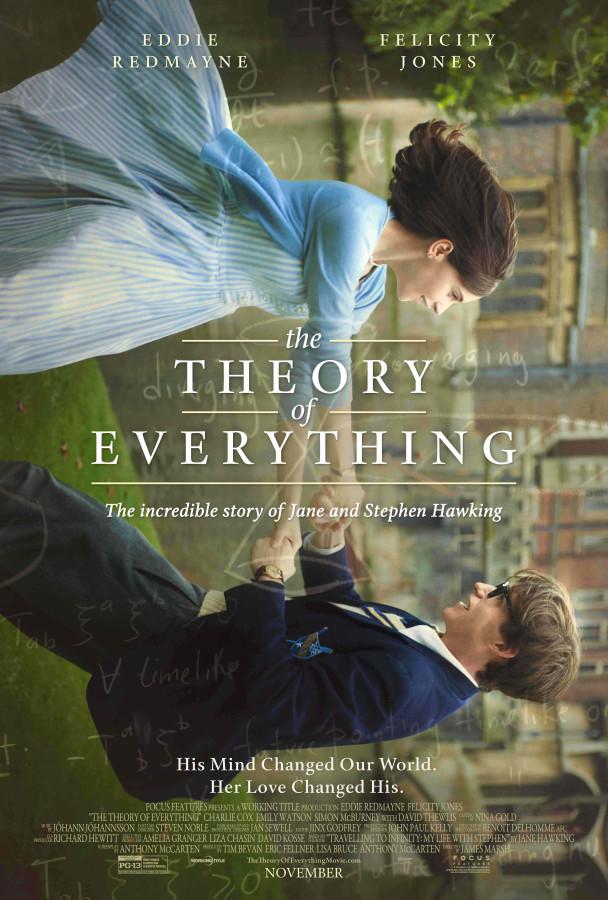What do you get when you mix a biopic and a love story? The Theory of Everything. The true story of Stephen Hawking and his wife, Jane Wilde Hawking, is the inspiration for this film.
The seasoned directing skills of James Marsh bring this story to life. Marsh has films like Shadow Dancer (2012) and Man on Wire (2011) under his belt.
Alongside Marsh are the impeccable acting skills of Eddie Redmayne, who plays Stephen Hawking. Redmayne brings a fire to his role like never before. Movie lovers might think that would be impossible since Redmayne has movies like Les Misérables (2012) and My Week with Marilyn (2011) on his resume. Felicity Jones plays Jane Hawking, formerly Wilde, before their marriage. Jones has a bit of an indie repertoire, with The Invisible Woman (2013) and Like Crazy (2011). Both actors were nominated for multiple academy awards for The Theory of Everything.
Beginning in Cambridge, England, in 1963, this film takes off with Hawking as a student attending Oxford University. He meets Jane at a party. She hands her number off at the end of the night and he never calls her. He waits and waits to call her and eventually, by accident, runs into her again. They attend a ball hosted by Oxford and the scene ends with them slow dancing after a fireworks display. This is where the simplicity of the film and the story ends.
If the audience is not familiar with the story of Hawking, then the camera angles that cinematographer Benoît Delhomme starts creating are important. The audience begins to see Hawking’s feet drag on the ground a bit while he is walking and his hands shake while he writes.
No more than 20 minutes into the film after these details are pointed out, Hawking takes an ugly spill in the courtyard and wakes up in the hospital. The doctor tells him that he has motor neuron disease. It’s a progressive disorder that destroys the cells in the brain that control muscle activity. Within months, Hawking’s muscles will gradually decay and he will lose the ability to speak, walk, breathe and swallow.
While Hawking is in the process of working on the thesis for his Ph.D., this disease seriously affects him. His thesis is one that leaves you thinking because it involves time and how the universe came about. He is working on creating an equation to explain it all.
“One simple equation, to explain everything. Wouldn’t that be nice?” he asked his professor during his Ph.D. presentation.
Hawking and Wilde get married immediately after this and as the film flashes forward, the audience sees them have three kids in total. The disease begins to affect Hawking harsher and harsher as the film goes on. After they move in together, Hawking slides and pushes himself to get up and down the stairs. An emotional scene is left for the audience during a dinner party with friends when Hawking needs to get upstairs and the disease has taken over his body a little more.
The Theory of Everything is put together by screenwriter Anthony McCarten. The film is based off of the memoir “Travelling to Infinity: My Life with Stephen” that Hawking’s wife wrote.
Although Jones does deliver a fantastic role, there was a bit lacking from the character written around her and the role of the caretaker, despite the circumstances. It seems as if we only see the calmer and sweeter sides of Mrs. Hawking, except for one mild breakdown that happens midway through their story.
But is she sweet and calm? For the most part, yes, but the audience is eventually introduced to Jonathan Jones (Charlie Cox) when Jane goes to audition for the church choir. He becomes a family friend, helping Mrs. Hawking with the kids and her husband.
Maybe the audience would want to hate Mrs. Hawking, maybe not. However, her husband does not leave this story without some blame in his corner either.
In a film about love, loss, life, and creation, the cast and crew work together to create a masterpiece out of the masterpiece that is Hawking, who is still alive today when the doctors only gave him two years to live when he was at Oxford in 1963.

